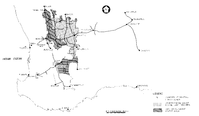


Chapter 3
I Background
II Early European Settlements
III Assessment Of Available Water Resources
IV Water Supplies For Goldmining Development
i Goldfields supply in Western Australia
ii The Coliban system of waterworks
V Irrigation Development
VI Farm And Stock Water Supplies
VII Urban Water Supplies
VIII Wastewater Management And Treatment
IX Water Quality Management
X Limnological And Water Quality Research
XI New Techniques In Water Resource Planning And Management
XII Legislation
XIII Conclusion
XIV List Of Abbreviations
XV Acknowledgements
XVI Plantations-high Productivity Resources
References
Index
Search
Help
Contact us

Goldfields supply in Western Australia
The discovery of gold in the Coolgardie and Kalgoorlie areas in 1892 and 1893 led to a large inflow of prospectors and an urgent requirement for a water supply for this hot, dry, semi-arid and previously unoccupied region. Early water supplies, from surface storages or distilled from brackish underground sources, were barely sufficient for drinking and cost 4.5 c/1.The ambitious and imaginative scheme conceived by C. Y. O'Connor, the first Engineer-in-Chief of Western Australia, was for the construction of a 21,000 ML dam at Mundaring in the Darling Ranges near Perth and the pumping of water by 8 major steam-driven pumping stations through a 557 km steel pipeline to the goldfields. Water was lifted 340 m from Mundaring Reservoir to Coolgardie (Fig. 1).

Work began in 1898 and, despite many difficulties including the need to supply most engineering materials from England, was completed in January 1903, the scheme providing 22,000 m3per day. This enormous task was rightly hailed as a unique technological triumph, involving a commitment by a State with a population of only 100,000 to the expenditure of $6,000,000. (All figures have been converted to 1987 dollars.)
The Goldfields and Agricultural Areas Water Supply Scheme now serves some 2.7 million hectares of farmland and 112 country towns and localities, as well as the mining areas, which now produce nickel and iron ore as well as gold. The original steam-driven pumps (Fig. 2) have been replaced by electrically operated pumps, additional water storage has been provided and the entire system is operated by remote control from a central station. It still rates as a major technological achievement.

Organisations in Australian Science at Work - Goldfields and Agricultural Areas Water Supply Scheme, W.A.
People in Bright Sparcs - O'Connor, C. Y.
 |
Australian Academy of Technological Sciences and Engineering |  |
© 1988 Print Edition page 156, Online Edition 2000
Published by Australian Science and Technology Heritage Centre, using the Web Academic Resource Publisher
http://www.austehc.unimelb.edu.au/tia/153.html